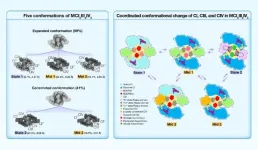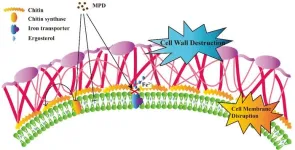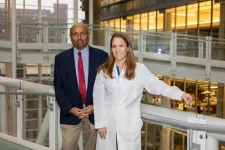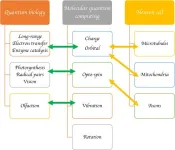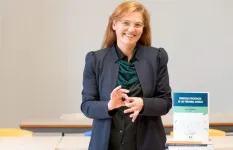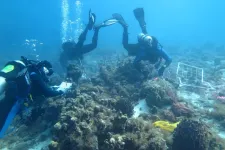Structural basis for the regulatory mechanism of mammalian mitochondrial respiratory chain megacomplex-I2III2IV2
2024-03-26
(Press-News.org)
Mammalian mitochondrial electron transport chain complexes are the most important and complicated protein machinery in mitochondria. Although this system has been studied for more than a century, its composition and molecular mechanism are still largely unknown. Here, Yang’s group report the high-resolution cryo-electron microscopy (cryo-EM) structures of porcine respiratory chain megacomplex-I2III2IV2 (MCI2III2IV2) in five different conformations, including State 1, State 2, Mid 1, Mid 2, and Mid 3. High-resolution cryo-EM imaging, combined with super-resolution gated stimulated emission depletion microscopy (gSTED), strongly supports the formation of MCI2III2IV2 in live cells. Each MCI2III2IV2 structure contains 141 subunits (70 different kinds of peptides, 2.9 MDa) in total with 240 transmembrane helices. The mutual influence among CI, CIII, and CIV shown in the MCI2III2IV2 structure suggests this megacomplex could act as an integral unit in electron transfer and proton pumping. The conformational changes from different states suggest a plausible regulatory mechanism for the MCI2III2IV2 activation/deactivation process.
Yang’s Group solved the high-resolution structures of porcine MCI2III2IV2 in five conformations, State 1, State 2, Mid 1, Mid 2, and Mid 3, classified according to the conformation of CI, the Rieske domain of CIII, and the position of CIV. MCI2III2IV2 was classified into two conformations, expanded and constricted, based on the position of CIV. The two CIs found in constricted forms of MCI2III2IV2 were all in the deactive state. By contrast, the two CIs in the expanded conformations of MCI2III2IV2 could be found in either active or deactive states, suggesting that MCI2III2IV2 shifts from the active state (State 1) to the deactive state (State 2), via the intermediates (Mid 1, Mid 2, and Mid 3).
The dynamic range of the 2Fe-2S cluster in State 1 largely aligned with that reported in the “b” state; the dynamic range in Mid 1 largely coincided with that in the “int” state; and the dynamic range in State 2 overlapped between the “int” and “c1” states. So, when MCI2III2IV2 shifts from State 1 to State 2, the Rieske domain of CIII changes from the “b” state to the “c1” state.
Moreover, in both State 1 and Mid 1, the distances between the Cyt.c binding site of CIV and the two Cyt.c binding sites of CIII are around 95 Å and 115 Å, respectively, while in State 2, these distances are about 73 Å and 78 Å, respectively. This finding suggested that Cyt.c could potentially diffuse more readily over the markedly shorter distances between Cyt.c binding sites in State 2. In addition, we noted that the density of Cyt.c gradually scatters from State 1 to Mid 1, and to State 2, indicating that Cyt.c is more tightly bound to CIII in State 1, while more loosely bound in State 2.
As MCI2III2IV2 shifts from State 1 to State 2, two points of interaction between CI and CIII on the IMS side undergo significant conformational changes. In particular, a long helix (C80-G126) of NDUFB7 extends from the distal end of the CI membrane arm to contact the Rieske domain of CIII monomer A, and the C-terminus of NDUFB10 protrudes from the middle region of the CI membrane arm to contact the N-terminal region of UQCRH of CIII monomer B. In State 1, the closest distances between these two interaction sites are ~15.3 Å and ~11.9 Å, respectively, while in State 2, these distances are reduced to ~6.0 Å and ~7.9 Å, respectively. The Rieske domain is critical for electron transfer within CIII, and the N-terminal region of UQCRH is adjacent to the Cyt.c binding site of CIII. Consequently, NDUFB7A123 and NDUFB10A176 of CI may function as two anchor points to induce conformational changes in the CIII Rieske domain and Cyt.c binding site.
See the article:
Structural basis for the regulatory mechanism of mammalian mitochondrial respiratory chain megacomplex-I2III2IV2
Doi: 10.1016/j.hlife.2024.03.003
END
ELSE PRESS RELEASES FROM THIS DATE:
2024-03-26
This study is led by Prof. Ying Li (Xuzhou Medical University), Prof. Zuobin Zhu (Xuzhou Medical University), and Prof. Wenqiang Chang (Shandong University). A small molecule library consisting of 40 compounds, specifically N-substituted maleimide and its derivatives were initially screened in the study. Among them, twelve maleimides, each with a distinct N-protection group, were synthesized using ring-opening and ring-closing reactions involving various amines and maleic anhydride. Additionally, a set of twenty-eight ...
2024-03-26
Researchers from the University of Tartu and the University of Copenhagen have proposed the theoretical description of an ideal electrocatalysis process, which, if implemented, could double the efficiency of energy conversion and storage devices.
As the world seeks sustainable solutions to meet escalating energy demands, a collaborative team of researchers from the Universities of Tartu and Copenhagen has proposed an innovative approach to overcome long-standing limitations in oxygen electrocatalysis. Oxygen electrocatalysis ...
2024-03-26
Researchers at the Keck School of Medicine, University of Southern California, have discovered that a protein called Piezo1 prevents a type of immune cell in the lung from becoming hyperactivated by allergens. The study, to be published March 26 in the Journal of Experimental Medicine (JEM), suggests that switching on Piezo1 could represent a new therapeutic approach to reducing lung inflammation and treating allergic asthma.
Type 2 innate lymphoid cells (also known as ILC2s) are a type of immune cell that resides in the lungs, skin, and other tissues of the body. ILC2s in the lungs become activated in the presence of allergens and produce ...
2024-03-26
Cardiac computed tomography angiography (CCTA or CTA) has emerged as a first-line tool for diagnosing, treating, and evaluating the prognosis of various cardiac diseases. In this special issue of JSCAI, "The Role of Cardiac Computed Tomography Angiography in Diagnosis, Treatment, and Prognosis of Cardiac Disease", experts detail the broad spectrum of uses of this imaging modality, acknowledging the role of this test in current clinical and procedural practice, including:
Risk stratification
Ruling out coronary artery disease in patients with chest pain
Assessing ...
2024-03-26
Simply asking patients to get the flu vaccine, and combining it with helpful video and print messages, is enough to persuade many who visit emergency departments to roll up their sleeves, according to a new study led by UC San Francisco.
Researchers found a 32% vaccine uptake in patients who were asked if they’d be interested in getting the flu shot and told their health providers would be informed. They saw a 41% uptake for those who were asked about receiving a flu shot and received a pamphlet, watched ...
2024-03-26
A multidisciplinary team of University of Cincinnati Cancer Center researchers have opened a Phase 2 clinical trial to test a new combination treatment for glioblastomas (GBM), the most deadly form of brain tumors.
The team, led by UC’s Pankaj Desai, PhD, and Trisha Wise-Draper, MD, PhD, has been awarded a Catalyst Research Award from the Dr. Ralph and Marian Falk Medical Research Trust to move the trial forward.
Study background
Difficult to diagnose at early stages, GBMs are aggressive brain tumors that become symptomatic once the tumor is substantial. Current treatments include ...
2024-03-26
An international research team led by RMIT University has designed and manufactured a virus-killing surface that could help control disease spread in hospitals, labs and other high-risk environments.
The surface made of silicon is covered in tiny nanospikes that skewer viruses on contact.
Lab tests with the hPIV-3 virus – which causes bronchitis, pneumonia and croup – showed 96% of the viruses were either ripped apart or damaged to the point where they could no longer replicate to cause infection.
These impressive results, featured on the cover of top nanoscience journal ACS Nano, show the material’s promise ...
2024-03-26
Diving deep into quantum biology or cognitive science alone is challenging enough. That being said, a research team recently wrote a review article highlighting molecular quantum computing, a newly emerged research area that is likely to push the research boundaries of both. The review was published Feb. 21 in Intelligent Computing, a Science Partner Journal.
Future theoretical breakthroughs may be achieved by connecting molecular quantum computing, the bridge research area, with cognitive science and quantum ...
2024-03-26
One of the features of the deaf community is that it is highly diverse. As well as including people of different ages and genders, the members of the community do not all share the same type of deafness or form of communication. Firstly, the time of onset of deafness and the degree of hearing loss vary greatly. And secondly, not everybody uses sign and oral language in the same way. All these aspects have a bearing on the well-being of deaf people. However, few studies specifically analyse the effect of each one.
The PhD thesis, defended by Amaia Jauregi-Orbe at the Faculty ...
2024-03-26
Named for its ropy-looking long branches, Aplysina cauliformis, a coral reef sponge, provides a critical 3D habitat for marine organisms and helps to stabilize the foundation of coral reefs. However, these upright branching sponges are highly susceptible to breaking during storms, which increases sponge fragmentation and contributes to population clonality and inbreeding.
Many sponges can survive severe damage and undergo frequent fragmentation, which is considered a mechanism for asexual reproduction. While fragmentation is a commonly utilized reproductive strategy in rope sponges, they also can reproduce sexually by producing larvae. How and whether they recolonize following ...
LAST 30 PRESS RELEASES:
[Press-News.org] Structural basis for the regulatory mechanism of mammalian mitochondrial respiratory chain megacomplex-I2III2IV2
